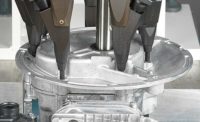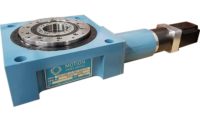Even though the Great Recession has passed, manufacturers in many industries are still adjusting to the reality of a downsized market struggling to get back to its glory days. This is particularly true for some automotive Tier 1 suppliers, who have had to master the art of production flexibility to stay competitive. One such supplier makes service parts for door panels of a vehicle model that was discontinued a couple years ago.
“Because the demand for parts has lessened over time, the company needed to remove a full assembly line and use the space for other work,” explains John Lanphear, founder and president of LTW Ergonomic Solutions Inc., which has made adjustable- and fixed-height industrial workstations and workbenches since 1999. “Last year, we were asked to build a custom workstation that, in essence, replaces the old assembly line and helps workers efficiently assemble small batches (five to 10 pieces) of replacement parts.”
Within a couple months, LTW developed a durable adjustable-height workstation with advanced capabilities based on its patented standard model. Made of 2-inch-square, 7-guage welded tube steel, the station measures 48 by 40 by 86 inches and comes equipped with a touchbutton motor controller and five swivel-locking casters. The laminated work surface is 1.5 inches thick. The surface tilts, raises up to 12 inches, and has a 1,100-pound lift capacity.
Lanphear says the workstation’s most unique feature, however, are four pallets stacked on an adjustable-height cart. Each pallet has a fixturing nest that holds a specific vehicle panel (front right, front left, rear right or rear left) in place. When assembly work is required on a specific panel, that pallet is slid onto the work surface. After work is completed, the pallet is moved back in place on the cart.
Since installing the workstation, the Tier 1 supplier has had no problem keeping up with part orders, and is using the extra floor space for other production work. It is also considering installing similar workstations at more plants. Meanwhile, Lanphear named the workstation the RCT-SL (rapid change technology—side load), made it a standard product and is marketing it and a smaller version to manufacturers in all industries.
Although workstations have always been essential for manual assembly, inspection and test operations, their importance was often overlooked. This is no longer the case, due to concerns about worker ergonomics (a movement begun in the late 1980s) and the increasing need for flexible manufacturing. A workstation that fails to meet both of these challenges daily is never a good investment—regardless of whether it has a low price or lots of features.
Categorically Embraced
Suppliers of workstations say there is no hard and fast rule regarding their categorization. It really depends on what the manufacturer needs for a specific application. Workstations can have a fixed- or adjustable-height work surface. They can be mobile or stationary. They can be a standard product or custom-designed. Some suppliers group their workstations according to assembly process, while others offer basic and advanced workbenches that function as workstations.
“Simple workstations haven’t changed,” says Keith Soderland, vice president of sales at Creform Corp. “They still feature a fixed-height work surface made of heavy-duty wood, metal or plastic, along with a shelf or two. More-advanced stations allow push-button electric height adjustment, come equipped with lighting, and allow the integration of a computer or the addition of tools like counterbalanced screwdrivers.”
A fixed-height workstation is most appropriate if one person uses it. When multiple workers use the workstation, a company may be inclined to average the height of all users and set the table at that height. This is not a good idea, says Lanphear. Making a worker reach just 1 inch more than necessary all day long will negatively impact his production and increase the risk of injury. The better approach is to use an ergonomic height-adjustable workstation.
“We prefer to categorize workstations by assembly process,” says Eric Dotson, general manager at Treston. “One-piece build workstations are where a single item is assembled from start to finish. Cellular build means subassemblies are made in a cell of workstations and then go to another cell for final assembly. Mobile assembly workstations move around large and, for the most part, stationary items.”
Most often, small and medium-size parts are assembled, inspected or tested on workstations. Lori Logan, marketing manager at DEPRAG, says assembly processes include installing fasteners, and pressing or bonding parts. Crimping or cutting wires is another common task.
To optimize worker productivity at any workstation, every part and tool needs to be within easy reach. Soderland says tool holders and holsters help workers grab, use and put away all sorts of hand tools. Balancing and positioning arms ensure proper ergonomic tool use and prevent worker fatigue. Fixtures keep parts secure during assembly.
Chris Maucher, president of item America LLC, says manufacturers of every size and in every industry use workstations. His company’s workstations are used to assemble products as diverse as medical catheters and automotive electronics. Camera-lens inspection and quality control are often performed on item workstations as well.
Founded in 2006, item America sells several kits with modular components that engineers can configure into hundreds of designs. The company’s work bench system (WBS) has been available since 2009. It features seven different benches, from which companies can create more than 1,100 configurations. Maucher says the company’s online configuration tool alone can produce more than 500 specific designs based on bench width, height and four different tabletop materials.
Two of the benches require manual height adjustment, and two can be raised or lowered by an electric motor. The others are a fixed-height, double-decker bench; a FIFO (first in first out) electric-height-adjustable unit with integrated conveyor; and a corner bench that allows for U-shaped workstations. Each workbench is shipped preassembled. Custom accessories can be installed by item during assembly or later by the manufacturer to save money.
Lista International Corp.’s Arlink 8000 modular workstation features a trim column profile that increases internal capacity for wire and utility management, and hides wires and hoses. LED overhead lights reveal the true colors of objects (color rendering index), and undershelf lights allow multiple mounting options. The workstation’s Definite Positioning System lets workers easily position and reposition accessories without tools. Other features include 15- and 20-amp power beams, and a redesigned light bracket that increases headroom over the bench top.
James Anderson, vertical market manager at Lista, says Arlink workbenches and workstations have been used by automotive Tier I suppliers for R&D and assembly of electronics and in infotainment labs. They’ve also been used by appliance manufacturers and aerospace companies in the manufacturing, test and repair of their products.
“Anyone who does some type of manual or semiautomated assembly work can benefit from a modern workstation,” points out Dotson. “This includes those who do kitting and packing—especially e-commerce order fulfillment. Although not traditional assembly work, per se, it does involve constantly moving products from bins and conveyors into bags and boxes. The workstation’s ergonomic layout lessens the strain on workers and makes them more productive and efficient.”
Less Cranky Than Before
When workstations were first introduced more than 30 years ago, their main selling point was manual height adjustability of the work surface. This was done by either raising the legs and pinning or bolting them in place, or turning a hand crank. Today, suppliers also offer workstations with surfaces that electronically raise or lower with the push of a button.
“The technological features of workstations have expanded significantly in recent years, beginning with electric height adjustment,” says Logan. “Stations are also available with built-in sensors, process control systems, power and data supplies, and feeders. Sensors verify all parts are present in a subassembly, while a pick-to-light system makes sure the worker performs an assembly task in the proper sequence. The supplied electrical feed can handle computers and medium- or high-wattage tools, like a soldering iron, while integrated feeders quickly bring parts or fasteners to the worker to save time.”
DEPRAG’s latest manual workstation features an aluminum base frame that comes in various sizes. Height adjustment is done electronically, and the workstation can be equipped with rotating part fixtures so workers can access an assembly from all sides. According to Logan, this latter feature is most important for one major automotive Tier II supplier that assembles dashboards and doors. The workstation frame also integrates into an assembly line and comes with a built-in parts feeder, pick-to-light display monitor, energy supply and LED lighting.
Manufacturers are increasingly requesting LED lighting in workstations because it is energy efficient, has a long wear life and easily attaches to rails, shelves and other surfaces. Dotson says Treston’s LED lighting has a lifespan of up to 100,000 hours (powered 24 hours per day for 11.5 years). The company’s magnetic mounting brackets increase lighting functionality and maneuverability.
All five of Treston’s ModuLine material flow modules quickly connect with each other to create an assembly line. Made of durable aluminum, the pre-engineered modules fit together in I-, L- and U-shaped production lines. Dotson says manufacturers can order module components based on required size and height either online or by phone.
The company’s LMT worktables enable people to ergonomically sit or stand while performing assembly, kitting, quality control, packaging, technical and laboratory work. Tabletops come in three sizes: 30 by 40, 30 by 48 and 30 by 60 inches. Each top is 1 inch thick and has a load capacity of 330 pounds. An integrated linear actuator lets the operator set the table frame at a height of 25.39 to 45.08 inches. The company also offers four upright kits that have a 176-pound maximum-load capacity and come with a wide range of accessories.
“End-users care as much about a workstation’s availability as they do its technological features,” claims Maucher. “Manufacturers need it within several days, not several weeks.” To limit downtime, item guarantees delivery of workstations or workbenches within 10 to 15 business days.
Depending on the task being performed, manufacturers may equip their facilities strictly with workstations, or complement workstations with workbenches. Anderson says motorized, height-adjustable workstations are excellent for companies that operate multiple shifts and employ many workers who assemble, inspect, test and pack parts of various sizes.
Creform has a small-assembly workstation that is constructed using a pipe and joint system. The workstation features a fixed-height worktable, an overhead light, a tool balancer and integrated flow rack with conveyors that bring in materials or parts, and transport finished assemblies to the next step of production.
Also available is a heavy-duty workstation made of 42-millimeter, plastic-coated steel pipe with a 1,000-pound capacity. It features a 4-by-3-foot work surface that electronically adjusts up to 12 inches, along with a tool holster, balancer and overhead lighting.
“Manufacturers are more knowledgeable about what’s available on workstations due to the Internet, and that’s a good thing,” explains Anderson. “Sometimes, though, they try to save money by making their own workbenches and accessories, and that is never efficient. It’s always better to work closely with their supplier.”







